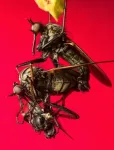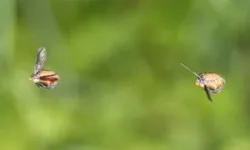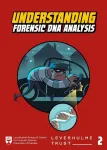(Press-News.org) With bloated bellies and hairy legs, female flies try to look bigger to get food from courting mates. But male flies, in turn, have sharpened their eyesight to call their bluff. A new study by researchers from the Universities of Gothenburg and Stockholm suggests that this is an ongoing evolution where both sexes try to outsmart each other.
For the first time, researchers have been able to show that also males can develop traits that help them pass on their genes despite the manipulative adaptations of the opposite sex. In different species of dance flies, there is a clear correlation between how richly decorated the female flies are and how large the eye facets are on the males. The researchers interpret this to mean that the males needed to develop better vision to find the optimal female in the swarm.
Dead insect as a nuptial gift
“We almost always see enlarged eye facets in male flies in those species where the female flies have developed hairy legs. Therefore, we dare to assume that there is a connection,” says Luc Bussière, evolutionary biologist at the University of Gothenburg.
There is an intricate interplay that takes place when the dance flies mate. The flies only fly for 1–2 weeks in their life cycle and that is when they have to reproduce by laying eggs that become fly larvae. To increase the chance that their genes will be passed on, male flies look for females that appear to have the most eggs. When mating, the male fly brings a gift, usually a dead insect, which he gives to the female. The female rarely hunts on her own and relies on the protein from the insect to produce eggs. Without an insect for the female, the male is usually not allowed to mate.
So how does a younger female fly without eggs attract male flies to get food supplies?
“We see that the females have different characteristics and tricks to imitate being fecund. They swallow air that fills their abdomen, and to look really big when they swarm, they have developed hair on their legs and their wings are bigger and darker,” says Axel Wiberg, researcher at Stockholm University.
The fact that animals imitate, behave and have appearances to fool the opposite sex is nothing new. Previous research on flies has also shown that male flies prefer a plump female fly to a skinny one when mating. But now scientists have discovered that male flies have sharpened their eyesight to avoid being fooled.
Sexual play evolves the species
By capturing male flies and measuring their eye facets, the researchers discovered that the facets on the top of the eyes were larger than those on the underside in the males of some species. Since the male fly approaches the female from below during mating, the researchers believe that the eyes have evolved to determine whether the female is truly full of eggs, or just faking it.
“This sexual play may force an evolution of the species. For generations, male flies with the largest facets have been favoured in mating and their genes are passed on. We see this as an evolutionary system where the development of different traits in male and female flies has been alternating,” says Luc Bussière.
Female flies of the different species in the study have different characteristics, some have only slightly darker wings, others have both darker wings and hairy legs, and can inflate their abdomen by swallowing air. These traits did not appear all at once, but probably as the male gets better and better at seeing past the bluff.
What will be the female's next move?
“Perhaps the female develops new traits that make it harder for the male to judge her size. Or she may develop entirely new strategies to gain an evolutionary advantage. For example, we see that in the species with the largest facets in the male, the female also has slightly enlarged facets – but on the underside of the eye. We don't know what this means, but perhaps it helps the female to see an approaching male more quickly and thus find an advantageous position in the swarm,” says Axel Wiberg.
Facts: The life of a dance fly
Adult dance flies lay eggs during the summer which then hatch into predatory larvae in the soil. The larvae hunt and eat other organisms and in the northern hemisphere are likely to become pupae before winter. In spring, the pupae complete their development and become flying insects; flies. Flies emerge at different times during the summer, for most species the flight period is only a few weeks at most. During this time, males and females gather in swarms to mate. In almost all of the dance flies from the subfamily included in the study, the males bring nuptial gifts to the mating swarm in the form of insects. During mating, the female feeds on the male's gift while the male inseminates her. Mating is repeated several times with different partners. Once the female has mated and eaten enough meals from the males, she can lay several eggs in the soil that will be the start of the next generation.
END
Male flies sharpened their eyesight to call the females' bluff
2025-02-05
ELSE PRESS RELEASES FROM THIS DATE:
School bans alone not enough to tackle negative impacts of phone and social media use
2025-02-05
Students attending schools that ban the use of phones throughout the school day aren’t necessarily experiencing better mental health and wellbeing, as the first worldwide study of its kind has found that just banning smartphones is not enough to tackle their negative impacts.
In a landmark study published today (Wednesday 5 Feb) in Lancet Regional Health Europe, 1227 students from 30 schools across England provided data about smartphone and social media usage and a range of mental health, wellbeing and other outcomes. ...
Explaining science in court with comics
2025-02-05
Imagine being summoned as a juror in a murder trial. The expert responsible for analyzing DNA traces at the crime scene has just explained that they match the defendant’s profile. “Then the culprit must be them,” you think. At this point, however, the expert adds: “The sample, however, is partially degraded.” What does this mean? How does this information affect your judgment? The scientist further explains that there is a one-in-a-billion probability that other people could match the identified genetic profile. ...
‘Living’ electrodes breathe new life into traditional silicon electronics
2025-02-05
Osaka, Japan – High-speed electronic devices that do not use much power are useful for wireless communication. High-speed operation has traditionally been achieved by making devices smaller, but as devices become smaller, fabrication becomes increasingly difficult. Have we reached a dead end?
Not yet! A research team at Osaka University is exploring another way to improve device performance: placing a patterned metal layer, i.e., a structural metamaterial, on top of a traditional substrate, e.g., silicon, to accelerate ...
One in four chance per year that rocket junk will enter busy airspace
2025-02-05
There’s a 26 per cent annual chance that space rocket junk will re-enter the atmosphere and pass through a busy flight area, according to a recent UBC study.
While the chance of debris hitting an aircraft is very low, the research highlights that the potential for uncontrolled space rocket junk to disrupt flights and create additional costs for airlines and passengers is not.
Space junk disrupting air traffic is far from unheard of. In 2022, a re-entering 20-tonne piece of rocket prompted Spanish and French aviation authorities to close parts ...
Later-onset menopause linked to healthier blood vessels, lower heart disease risk
2025-02-05
Women who go through menopause later in life have healthier blood vessels for years to come than those who go through it earlier, according to new University of Colorado Boulder research.
The study, published in the American Heart Association journal Circulation Research, offers new insight into why females who stop menstruating at age 55 or later are significantly less likely to have heart attacks and strokes in their postmenopausal years.
Arriving just in time for Women's Heart Health Month, in February, the findings could help lead to new therapies, including dietary interventions, to reduce risk of heart ...
New study reveals how RNA travels between cells to control genes across generations
2025-02-05
RNA-based medicines are one of the most promising ways to fight human disease, as demonstrated by the recent successes of RNA vaccines and double-stranded RNA (dsRNA) therapies. But while health care providers can now successfully develop drugs that use dsRNA to accurately target and silence disease-causing genes, a major challenge remains: getting these potentially life-saving RNA molecules into cells efficiently.
A new study published in the journal eLife on February 4, 2025, may lead to breakthroughs in RNA-based drug development. University of Maryland researchers used microscopic roundworms ...
Women health sector leaders good for a nation’s wealth, health, innovation, ethics
2025-02-05
Women health sector leaders are good for a nation’s wealth, health, innovation, and ethics, among other things, finds a review of the available evidence, published in the open access journal BMJ Global Health.
Yet despite their unique and positive impact, they are a major underused resource, particularly in low and middle income countries, say the researchers, who call for more and sustained investment to maximise women’s potential and reap the benefits of their contribution.
Despite making up 70% of the healthcare workforce, as a whole, and 90% of the nursing ...
‘Good’ cholesterol may be linked to heightened glaucoma risk among over 55s
2025-02-05
‘Good’ (HDL) cholesterol, usually considered to be beneficial for health, may be linked to a heightened risk of the serious eye condition, glaucoma—at least among the over 55s— suggest the results of a large observational study, published online in the British Journal of Ophthalmology.
Paradoxically, ‘bad’ (LDL) cholesterol, usually regarded as harmful to health, may be associated with a lower risk of glaucoma, a condition that damages the optic nerve, potentially leading to irreversible sight ...
GLP-1 drug shows little benefit for people with Parkinson’s disease
2025-02-05
The GLP-1 drug, exenatide, has no positive impact on the movement, symptoms or brain imaging of people with Parkinson’s, finds a new study led by UCL researchers.
The world’s largest and longest trial of exenatide in people with Parkinson’s disease was funded by the National Institute for Health & Care Research (NIHR) with support for sub-studies from Cure Parkinson’s and Van Andel Institute.
For their research, published in The Lancet, the team designed a randomised controlled phase 3 trial to definitively determine whether exenatide use was associated with any benefit in people with Parkinson’s and ...
Generally, things really do seem better in morning, large study suggests
2025-02-05
Generally, things really do seem better in the morning, with clear differences in self-reported mental health and wellbeing across the day, suggest the findings of a large study published in the open access journal BMJ Mental Health.
People generally wake up feeling in the best frame of mind in the morning but in the worst around midnight, the findings indicate, with day of the week and season of the year also playing their part.
Mental health and wellbeing are dynamic in nature, and subject to change over both short and extended periods, note the researchers. But relatively few studies have looked at how these might change over the course of the day, and those studies that ...





